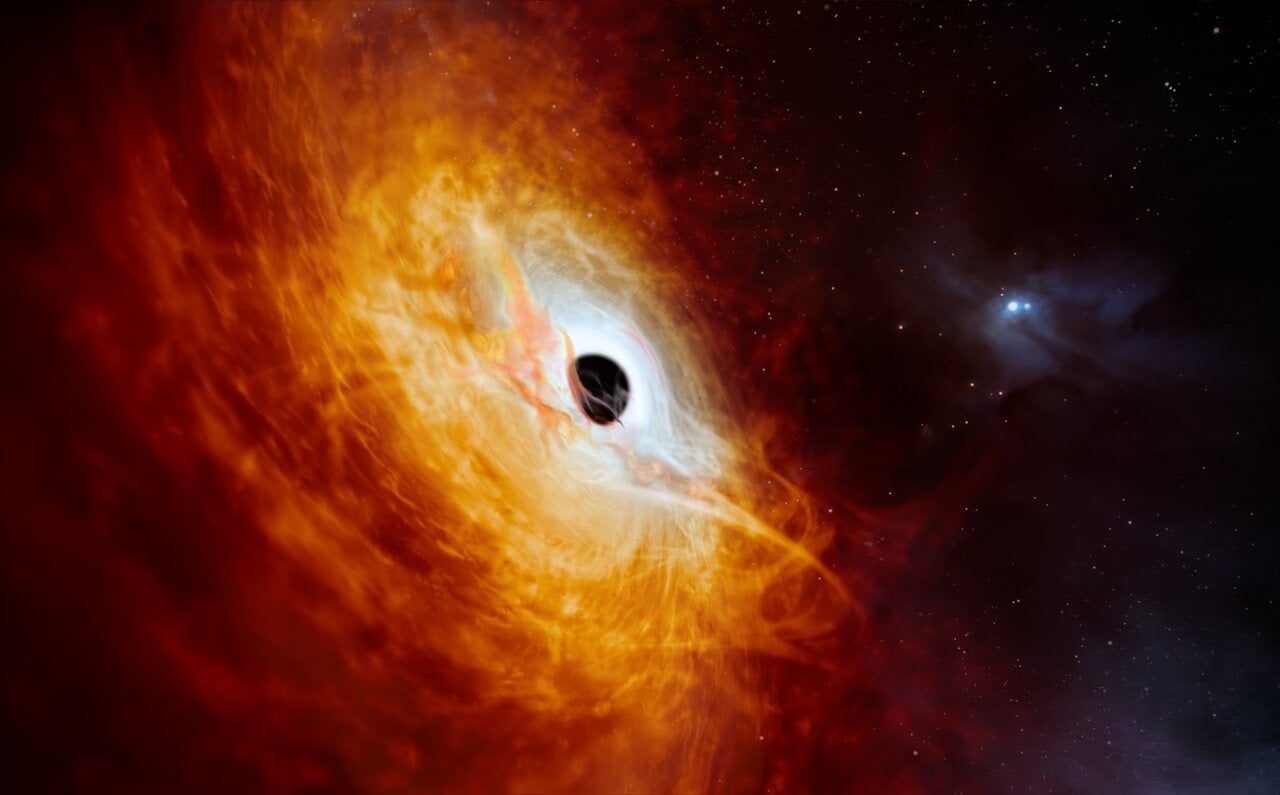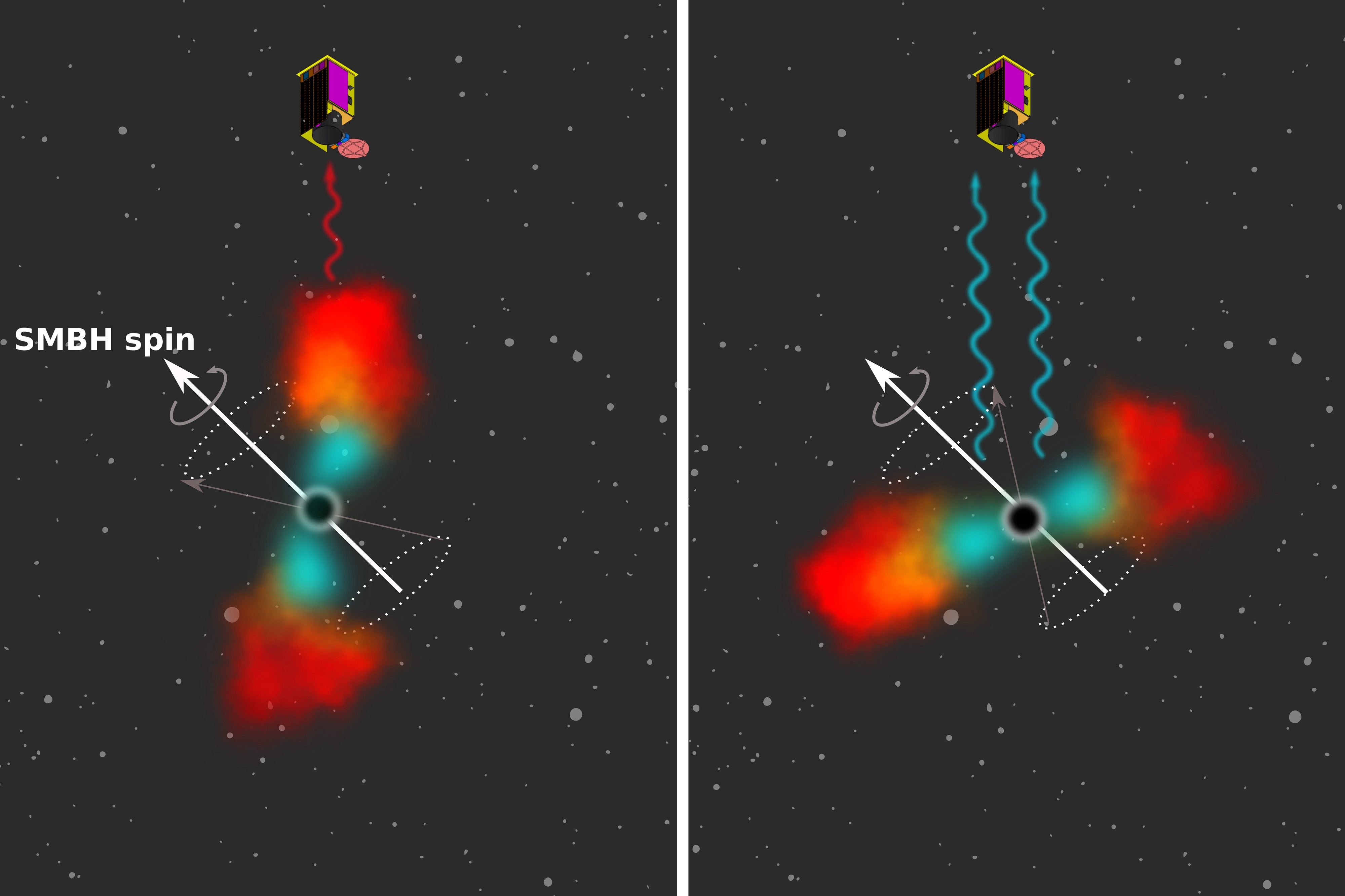
Supermassive black holes lie in the centers of all large galaxies. And a group of astronomers including researchers from MIT and NASA have, for the first time, measured how fast one of these behemoths is spinning. They did so by analyzing the aftermath from the black hole’s recent meal of star stuff.
This pioneering technique makes use of tidal disruption events (TDEs), which occur when a star passes too close to a black hole and is torn apart as a result. This creates a bright, rotating disk of stellar material around the black hole, known as an accretion disk.
The team, led by MIT Research Scientist Dheeraj “DJ” Pasham, tracked X-ray flashes from the black hole for several months. Those flashes, they concluded, were generated as the newly created accretion disk bobbled back and forth under the influence of the central black hole’s own spin. That’s because as a black hole spins, it drags the adjacent fabric of space-time with it, which can affect nearby objects — such as an accretion disk. So, by working out the nature of that influence, the team could ultimately calculate how fast the black hole is spinning: at a rate of less than 25 percent the speed of light. Relatively speaking, that’s pretty slow.
Now the method can be applied elsewhere to perhaps hundreds of other nearby black holes, according to Pasham. In a press release accompanying the study’s publication, he said that “by studying several systems in the coming years with this method, astronomers can estimate the overall distribution of black hole spins and understand the longstanding question of how they evolve over time.”
How to grow a supermassive black hole
Supermassive black holes are, as the name implies, the largest type of black hole. Their masses range from hundreds of thousands to millions or even billions of solar masses.
LEARN MORE: How do scientists weigh celestial objects? | Astronomers clock a black hole spinning at half the speed of light
“Black holes grow in two ways: either by accreting gas or by merging with other black holes,” James Miller-Jones, a professor at the Curtin University node of the International Centre for Radio Astronomy Research, tells Astronomy.
However, exactly how and when supermassive black holes grew to their current size is not clear. “It is challenging to grow the most massive observed black holes in the time available,” Miller-Jones says. “A better understanding of black hole spins could help explain how some of the cosmic behemoths — black holes of several billion solar masses or more — grew to their observed masses in the available time,”
That’s because, he says, the way in which a black hole was grown is reflected in its spin. Black holes that simply accreted material from a stable disk should spin quickly. But “more chaotic accretion, such as from tidal disruption events, where the initial orbit of the shredded star could have been in any direction, is expected to lead to lower spins,” he says.
The latter effect is because “some [TDE] episodes would spin the black hole in one direction and others in the opposite direction,” says Adam Ingram, Lecturer in Astrophysics at Newcastle University in the UK.
So overall, Ingram says, measuring black hole spin is thus key to understanding how galaxies formed and grew in tandem with their central supermassive black hole.
“This study finds that the supermassive black hole has a fairly modest spin, implying that it grew via many short, sharp episodes,” Ingram says.

A valuable knowledge steppingstone
Additionally, Rob Fender, Head of Astrophysics at the University of Oxford, says being able to measure the spin of a black hole and understand how it affects the space-time around it is a key test of general relativity and astrophysics.
“It is hypothesized — and even accepted as a paradigm in some quarters — that you need a rapidly rotating black hole to produce the powerful relativistic jets we see with radio telescopes. If more studies like this can convincingly measure the spins of black holes and compare to independent estimates of jet power, this is an important advance,” Fender says.
Of course, black holes are notoriously difficult to study, notes Michael Nowak, Professor of Physics at Washington University in St. Louis, Missouri. “Black holes give us so few “dimensions” to work with — pretty much just mass and spin, and secondarily age, and maybe thirdly the kind of galaxy it is in — that trying to tease apart their differences to understand their formation is really tough,” he says. “The better we can get a handle on mass, spin, age, and location — and spin is by far the trickiest of those four to identify and measure — the better our prospects of understanding their formation.”
Miller-Jones also believes that the technique developed by Pasham’s team holds “great promise” for the future. “Black holes are extreme objects that we cannot recreate in a lab here on Earth. Any improvement in our understanding of black holes tells us more about the behavior of mass and gravity at the most extreme densities,” he says.
Plus, he adds, this study complements current gravitational-wave work to detect merging black holes, while future observations from the anticipated Laser Interferometer Space Antenna, set to launch in about a decade, might be able to directly detect merging supermassive black holes.
“Combining the information about black hole mergers from those gravitational wave observatories with that from electromagnetic studies such as this X-ray technique should significantly improve our understanding of how supermassive black holes grow and evolve over time,” he says.
Related: Black holes for beginners









